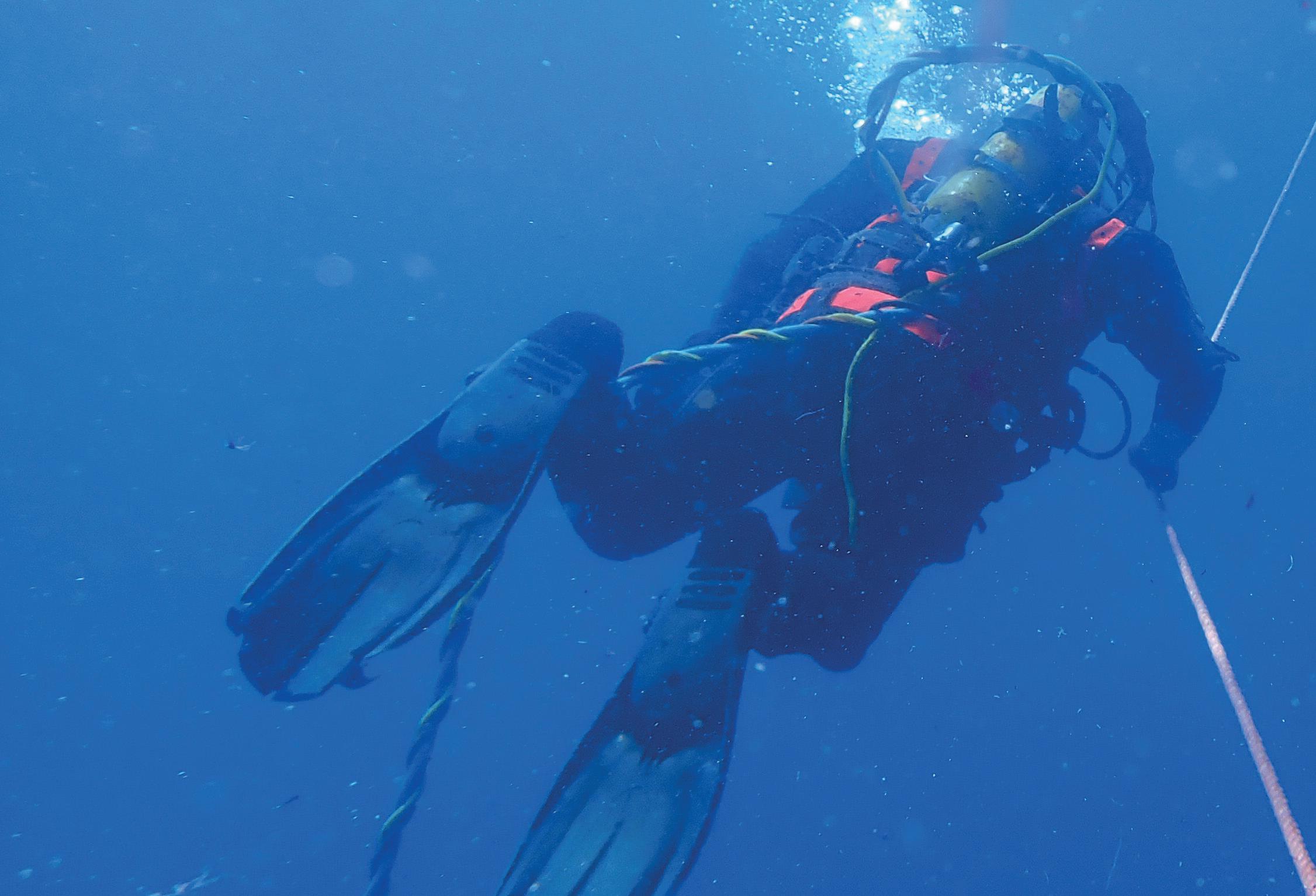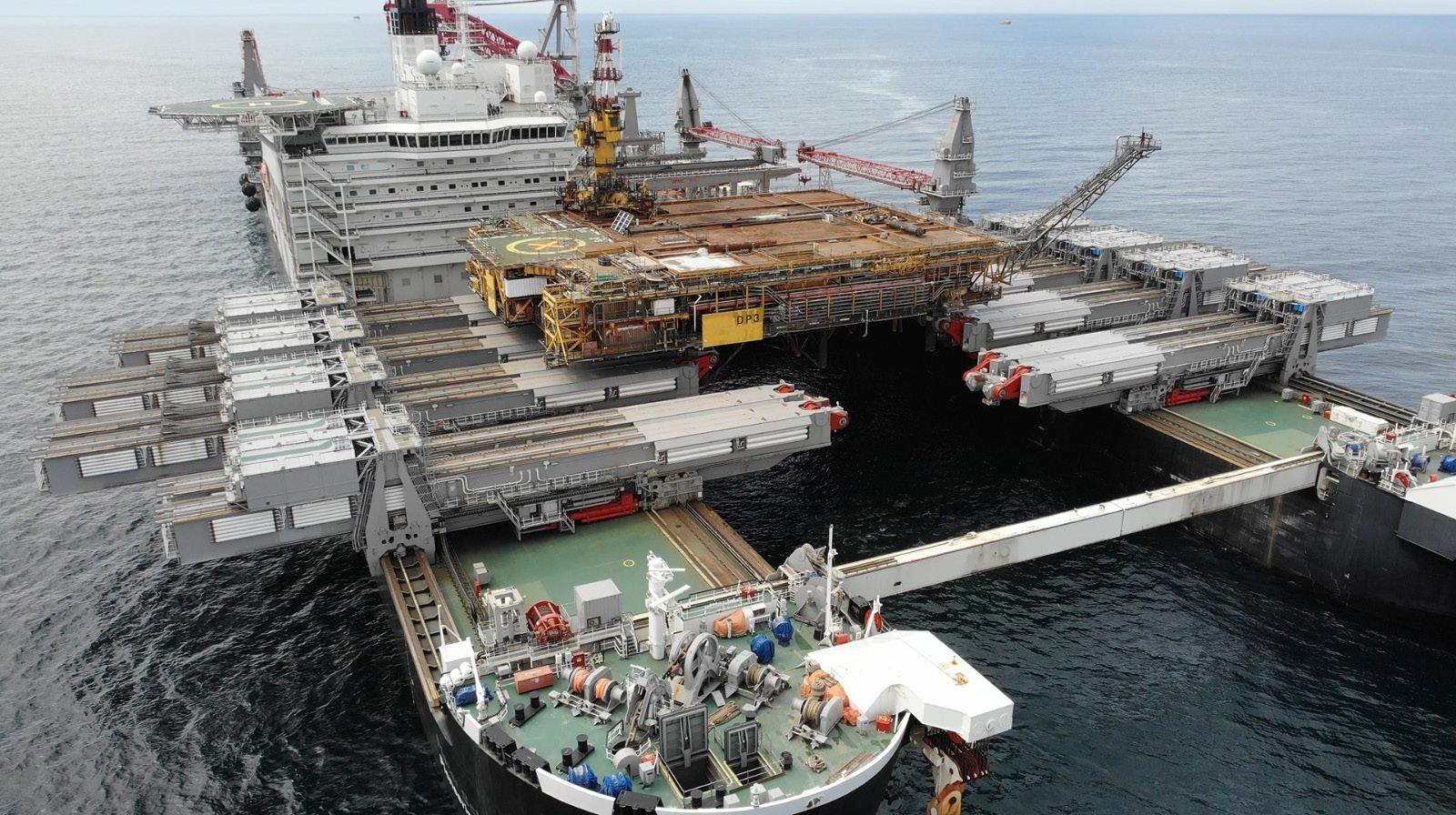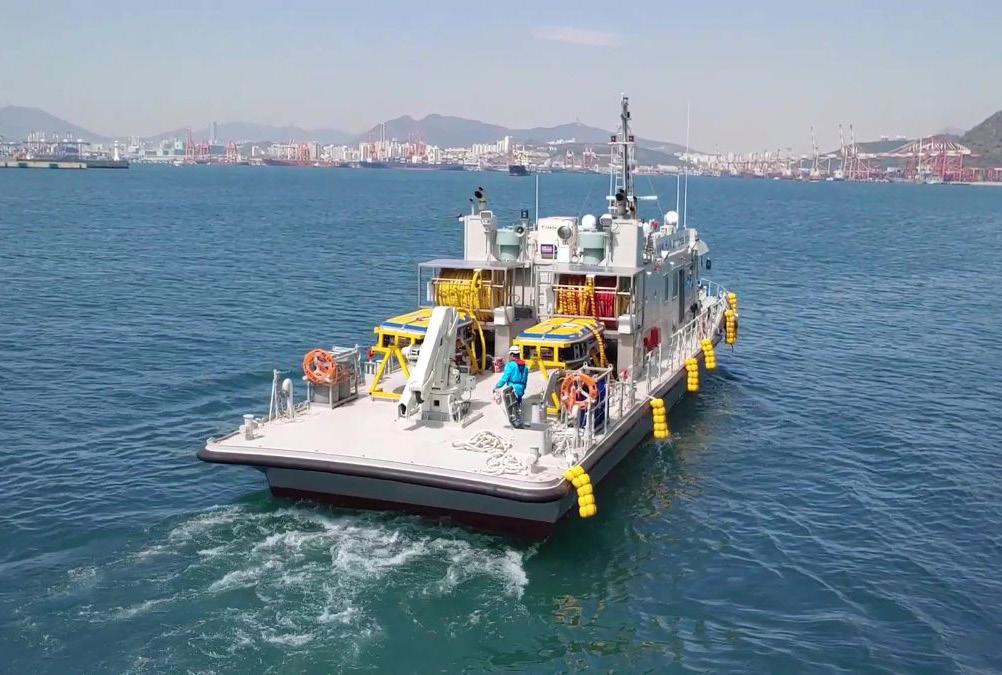
19 minute read
Underwater Repairs
The HullWiper support boat in Pusan
New location for HullWiper
Advertisement
Dubai’s HullWiper has launched operations at its newest location - South Korea. Through a partnership with HullWiper Korea, a company based at the Korea Maritime and Ocean University in Busan, it will provide green, sustainable and affordable hull cleaning solutions to all vessel types calling at the country’s main ports.
Hull cleaning in South Korea is highly regulated to prevent illegal operations performed by divers contaminating local waters with biofouling. HullWiper offers the most eco-friendly solution using Remotely Operated Vehicles (ROVs) to remove and collect all debris from hulls without releasing them into the sea.
By deploying two ROVs simultaneously, HullWiper saves time for ship owners and operators as cleaning can be performed in half the time needed for a single ROV. HullWiper Korea has also designed and developed the ‘Esther’, an eco-friendly vessel to transport the two ROV units to ports in Busan, Ulsan, Pohang, Masan, Jinhae, Yeosu and Gwangyang. The combination of the fast-moving ‘Esther’ transport vessel and the two ROVs enable a capesize vessel’s hull to be cleaned within eight hours. Recent hull cleans for vessels currently in cold and hot lay ups due to the COVID-19 pandemic have shown remarkable results in terms of fuel savings once they are reactivated after being cleaned.
HullWiper’s cost-effective, brush- and diverfree approach is an alternative to traditional methods and protects both vessels’ expensive anti-fouling coatings and marine ecosystems. HullWiper’s ROV is 100% environmentally friendly with all pollutants removed during cleaning and collected by a unique on-board filter unit for safe disposal onshore. The system uses adjustable seawater jets as the cleaning medium, instead of brushes or abrasives, to minimise the risk of damaging coatings. Removing fouling from vessels’ hulls results in optimal performance, energy efficiency and reduced CO2 emissions, while avoiding the expense of recoating in case of damage. In addition, no divers are used, limiting risk to human life, and allowing cleaning to be conducted day or night, in most weather conditions, and while cargo operations are underway.
“Extending the HullWiper family into Korea makes perfect sense,” says Simon Doran, HullWiper Managing Director. “Korea has industry leading new-build shipyards, and is a major location for all types of shipping from ro/ro vessels to LNG tankers. Supporting our Principals with the option of another location increases our global footprint and helps them reach their sustainability targets.”
“Time is money for shipping lines,” adds Byungsoo Yoon, HullWiper Korea Managing Director. “The launch of our operations will correct decreased voyage speed and reduce high fuel costs due to fouled hulls for vessels calling in Korea, it will also enhance the green corporate image for ship owners, operators and shipping lines.”
Mr Yoon highlights that while the cost of cleaning with the HullWiper is similar to that charged by diving companies, the turnaround result differs significantly - traditional methods can take up to five days to complete a full hull
clean, compared to the matter of hours it takes with HullWiper.
HullWiper Korea joins the fast-growing global network of hubs operating under HullWiper’s lease agreement, which was introduced in 2017. Since its launch in late 2013, HullWiper has expanded from its first base in Dubai to key locations across the Middle East, as well as ports in Australia, Denmark, Egypt, Gibraltar, Mauritius, Namibia, Norway, Panama, Singapore, Sri Lanka and Sweden.
Miko Marine’s first magnetic blanking leaves for Brazil
The first magnetic blanking set destined for the Brazilian offshore sector has left the Miko Marine fabrication plant in Haugesund, Norway. After six weeks of manufacture, the set is now en route to the DSIC yard in Dalian, China. It will then be installed aboard a new Floating Production Storage and Offloading (FPSO) vessel being completed by Japanese platform builder MODEC. On leaving Dalian the new FPSO will be moved to the Bacalhau field offshore Brazil where it will be operated by Equinor.
The new blanking set consists of four cofferdams that can be used for covering sea chests and three inlet pipe covers. Featuring Miko’s distinctive black on yellow trade mark colour scheme, their unique magnetic attachment system enables them to be quickly fitted over a hull opening by divers or ROV. They create an immediate water-tight seal without the need for any welding or hull attachments and can be quickly removed for recovery and storage until needed again. The ability to enable repairs and maintenance to be conducted without dry docking is seen as a major cost benefit and necessity for rigs and platforms which can remain on-station throughout.
Cato Stoll, managing director of Miko Marine, believes the delivery operation marks the completion of an important contract for Miko. “This is the culmination of a great deal of hard work and the application of detailed expertise by the Miko design team,” he said. “The team’s specialised knowledge and experience ensures that the magnetic blanking set will function safely and reliably for many years to come. When the new FPSO is on station offshore Brazil it will possess an operational cost benefit that is unique among FPSOs in the region.
“Designing and manufacturing the blanking set while the FPSO was under construction provided us with many benefits in terms of convenience and ease of work. Nevertheless, we frequently provide the same service as a retro-fit for ships and platforms whose operators want to avoid the cost and complications of ad hoc blanking contracts,” he said.
Miko Marine has developed considerable experience in the design and manufacture of hull closures and cofferdams and has particular expertise in the use of magnetic technology. Each cofferdam or pipe blank is kept in place by a configuration of powerful Miko MAM permanent magnets. With each magnet being capable of holding up to 1000 kg it is possible to achieve an immediate watertight seal for the closures without the need for any other fastening devices being fitted to the hull.
The Miko MAM range also offers magnets with holding powers up to 2,000 kg which can be used if a project demands it. Flotation material is integrated within the blanking plates and this makes them neutrally buoyant and easily handled under water by ROV or divers. Each magnet is attached to its closure by a flexible joint that enables the plate to be


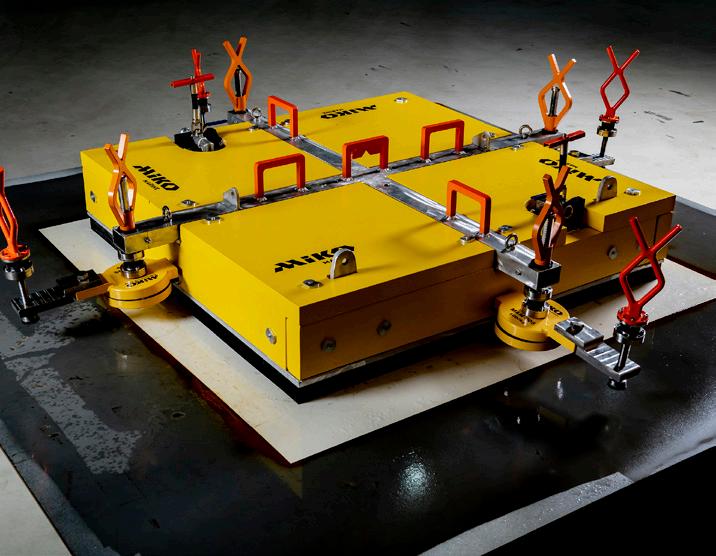
The Miko Marine cofferdam and the pipe closure
manoeuvred and positioned precisely against the hull before it is tightened into place. When the repair work is finished the magnets are simply freed by having their release lever rotated by a diver or ROV, enabling the blank to be quickly retrieved by crane and stored on-board.
Miko Marine is based in Oslo, Norway, from where it also provides a range of unique salvage and support products for the marine industry. Most widely known is its range of magnetic plasters which can be used to seal hull damage and enable a vessel to be moved safely to a yard for permanent repair. The company’s most recent innovation has been the Moskito oil recovery tool that was recently introduced as the first device that can enable bunker fuels and other hydrocarbon cargoes to be quickly and easily extracted from the tanks of sunken vessels.
International work by Hydrex

In just over a week Hydrex’s diver/technicians travelled to Finland, Germany, the Netherlands and France to assist shipowners with damaged propeller blades. On two bulkers the blades were cropped while on a third bulker and a general cargo vessel the bent blades could be straightened. In all cases the best solution was offered to the customer to restore the propeller’s efficiency as close to the original condition as possible.
One of the propeller blades of a 180 m bulker was severely bent. A fast, on-site solution to restore the propeller’s balance and efficiency was needed. Hydrex therefore sent a team to the ship’s location in Rotterdam along with a workboat.
After the equipment arrived the team started the operation with a detailed survey of the ship’s propeller. This revealed that one of the other three propeller blades was also bent slightly. It was decided to straighten this blade as well.
With the survey completed and in close communication with the team leader in the monitoring station on-shore, the divers returned the bent blade to its original state. When the straightening was complete, the technicians polished the blade to make sure that any remaining loss of efficiency would be minimal. The same procedure was then repeated on the other damaged blade.
The conditions for a similar repair in Tornio, Finland were a lot less warm. All four blades of a 144 m general cargo vessel were bent. Hydrex mobilised a team to straighten the blades using the same procedure as on the vessel in Rotterdam. They travelled through the snowy landscapes with two vans and the needed equipment to the ship’s location.
During the operation the divers had to work in water filled with chunks of ice, but these conditions offered no problem for them. They are used to adapt to different circumstances and carried out the repair without any loss of quality.
If straightening is not an option, the affected area on the blade will be cropped. By doing this the greatest possible efficiency is achieved for the vessel. This was the case for the operations described below.
With all four blades of a 235 m bulker’s propeller severely damaged after impact with ice, the engine was overloading. Hydrex was asked to perform an on-site repair during the ship’s stop in Rostock, Germany.
After the equipment arrived at the vessel’s location, the team started the underwater operation with a detailed survey of the affected propeller blades. They then used the information acquired during the inspection to calculate and determine the correct measurements needed to crop the blades.
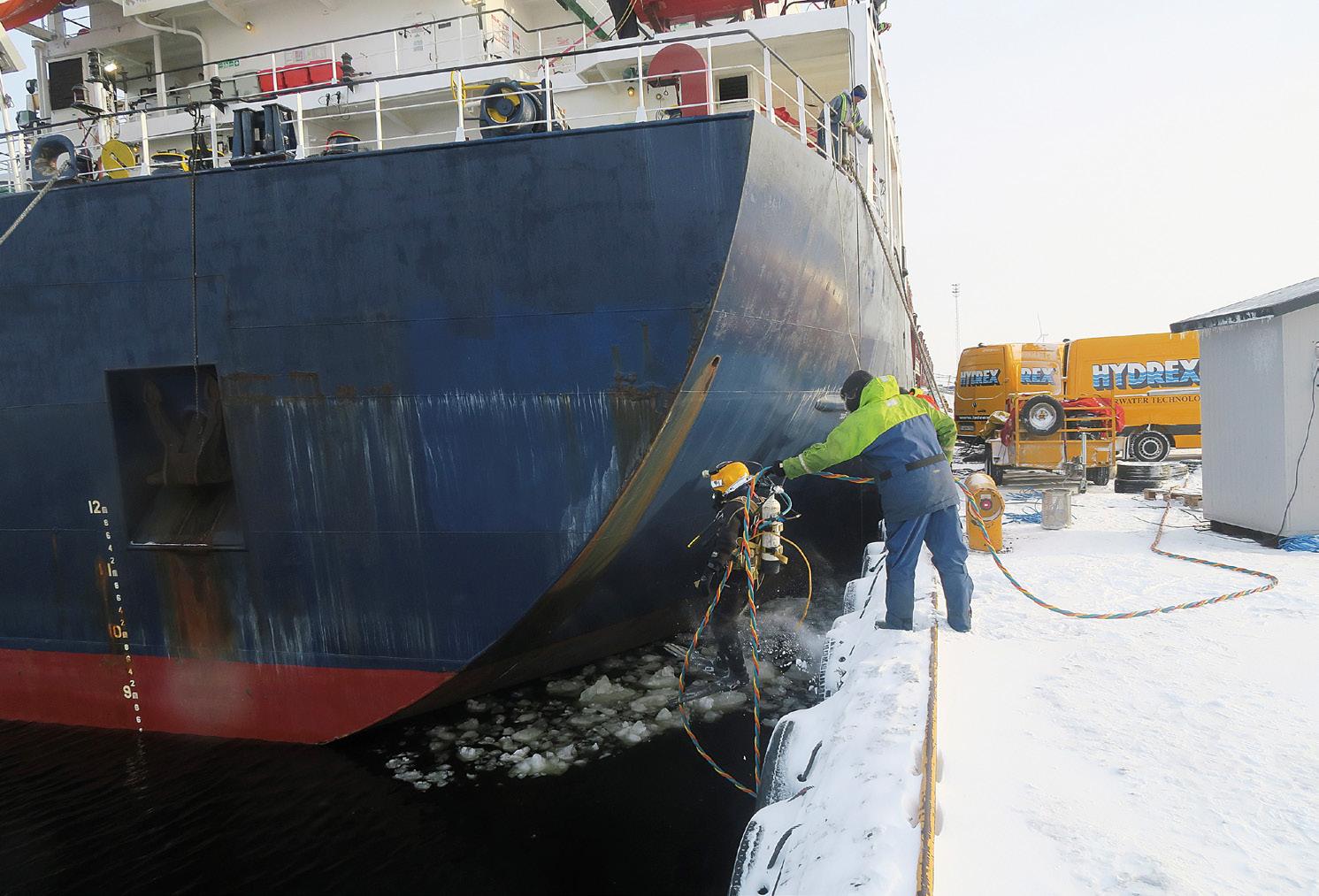
Hydrex divers operating in Finnish waters
Preparing the bow thruster in Zeebrugge for reinstallation during nightshift
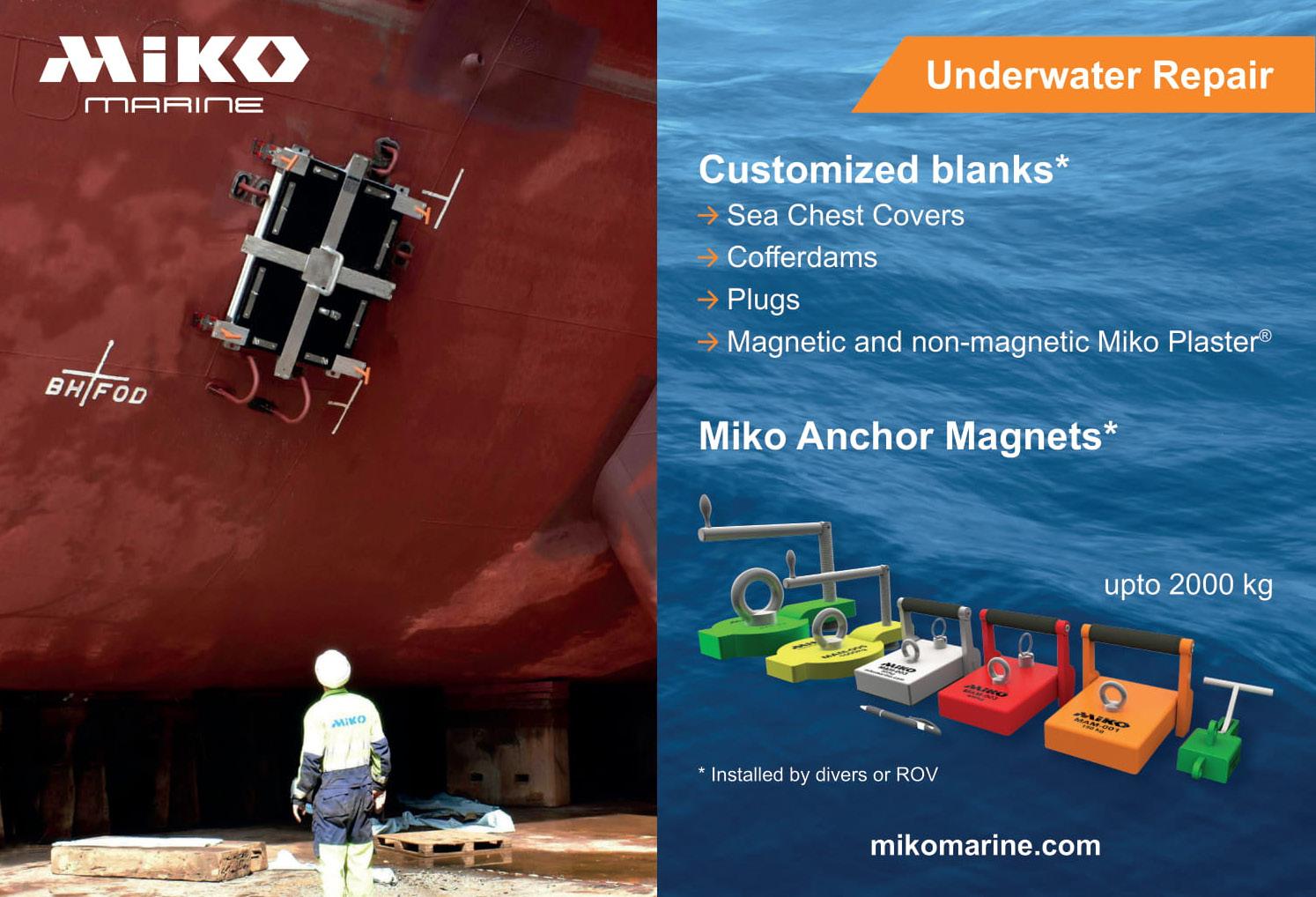
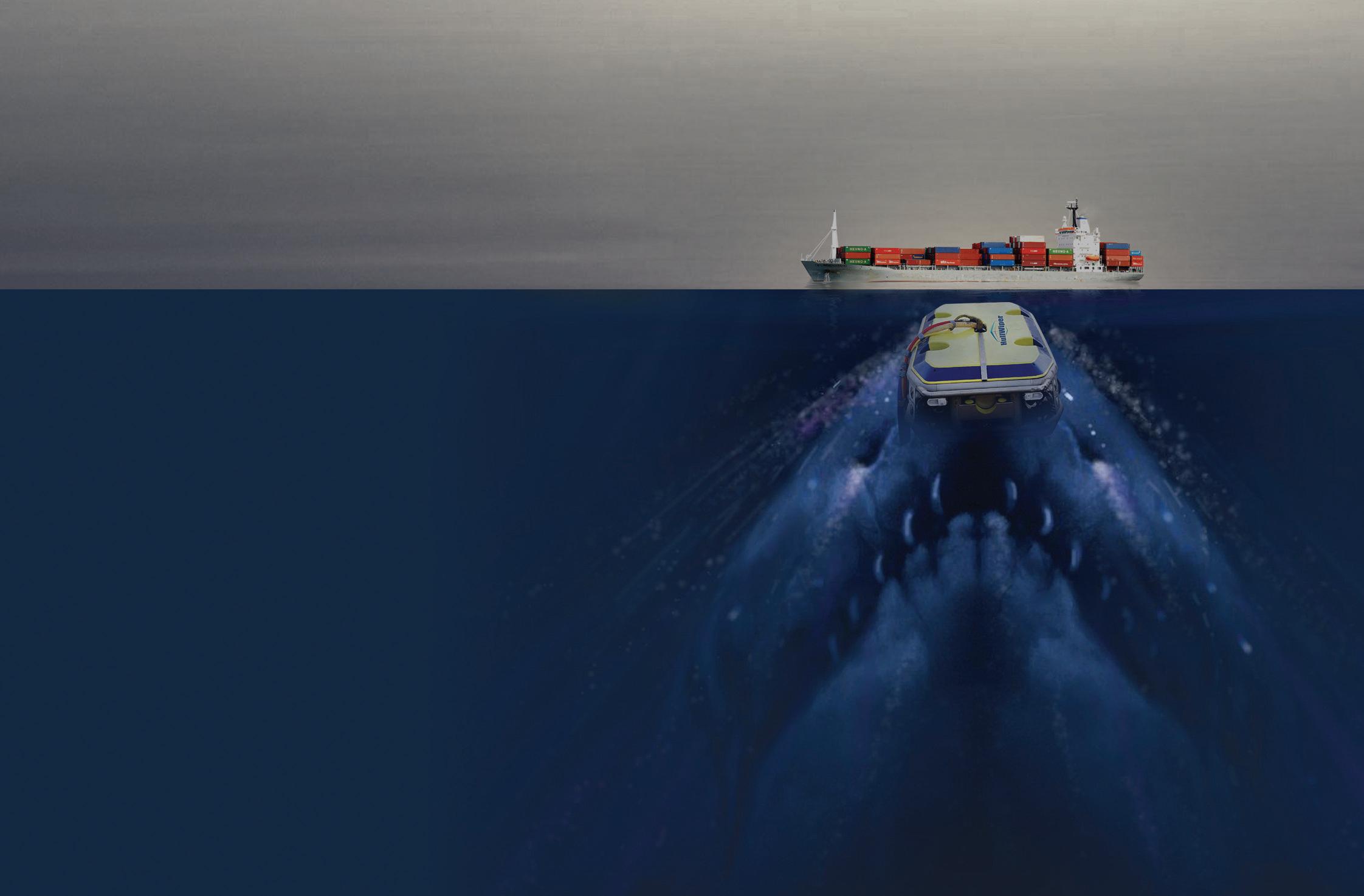
Lifting a propeller cone
Next the divers cropped the blade tips. When the cropping was complete, the blades were smoothened. The five-blade propeller of a 229 m bulker had unfortunately suffered a similar fate. An identical repair was carried out by the diver/technicians in Dunkerque. The result of the operation was also the same - the propeller’s balance was restored and the efficiency was brought back to optimum condition.
Hydrex also recently performed afloat bow thruster operations on container ships in Belgium and Spain. In Algeciras a thruster was removed on a 306 m vessel and in Zeebrugge a unit was reinstalled on a 135 m ship. All the necessary equipment was mobilised from the company’s fast response centre in Algeciras for the operation in Spain. After the team set up a monitoring station, the diver/technicians detached the blades one by one. In the meantime preparations were made in the bow thruster engine room for the underwater removal of the unit to avoid any ingress of water once it was taken out.
The next step was to secure the gearbox with hoisting equipment. The team then disconnected the unit from the bow thruster engine room and lowered it onto a cradle. This cradle was designed especially for such operations. The bow thruster was then brought to the surface. Simultaneously they sealed off the tunnel from the bow thruster room. Once the unit was lifted onto the quay it was prepared for transport to the workshop.
The ship in Zeebrugge could be trimmed enough to raise most of the bow thruster tunnel above the water. This allowed Hydrex to manoeuvre the thruster unit inside the tunnel with the propeller blades already installed.
Next, temporary metal plates were used to seal off the bottom of the tunnel. The divers could then empty the remaining water and perform the required welding work on the thruster brackets and the tunnel grids in dry conditions.
Recently, Hydrex installed propeller cone fins on two chemical tankers - one in Antwerp and one in Rotterdam. Both operations were carried out with the company’s dive support workboats. Stationed in these ports, they allow for immediate mobilisation.
A direct result of these underwater operations is that an owner can instantly start benefitting from the fuel savings a propeller cone fin brings. The owner does not have to wait until the next scheduled drydocking for the installation.
Propeller caps like these can recover energy loss of a propeller hub vortex in the propeller’s slipstream. This decreases fuel consumption from 3% up to 5% according to the manufacturers and reduces cavitation on rudders and hulls. Hydrex can install propeller cone fins underwater on any size and make of propeller, on both newbuild and in-service vessels. Hydrex carries out these operations following the specific procedures required by the involved OEM, adapted for an underwater installation.
After a preliminary inspection the divers remove the propeller cap and clean the flange where the device is to be installed. They then lower the propeller cone into the water and position it on the propeller. The bolts are put on the correct torque and secured. Hydrex teams can work in shifts around the clock to finish the operation as quickly as possible.
The owner of the vessel can start enjoying the fuel savings the propulsion improving device creates right away. Not having to wait for the next scheduled drydocking to have the propeller cone fin installed can win him up to four years of fuel savings. In contrast, he will have earned back the cost of the underwater installation in only a few months. The savings are considerable.
Meanwhile, Hydrex performed afloat bow thruster operations on containerships in Belgium and Spain. In Algeciras a thruster was removed on a 306 m vessel and in Zeebrugge a unit was reinstalled on a 135 m ship. All the necessary equipment was mobilised from Hydrex’s Algeciras fast response centre for the operation
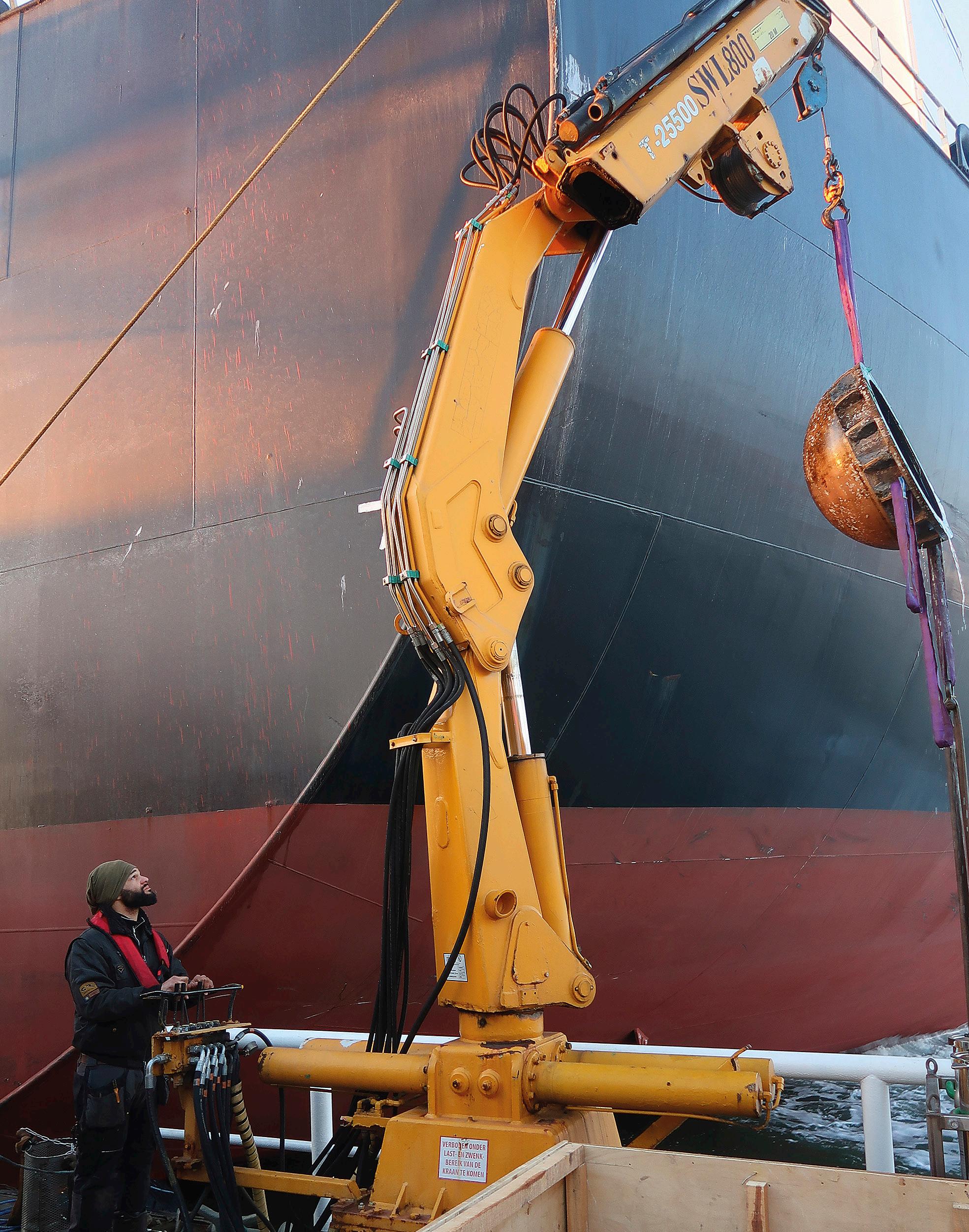
FULL PAGEAD RANDIVE
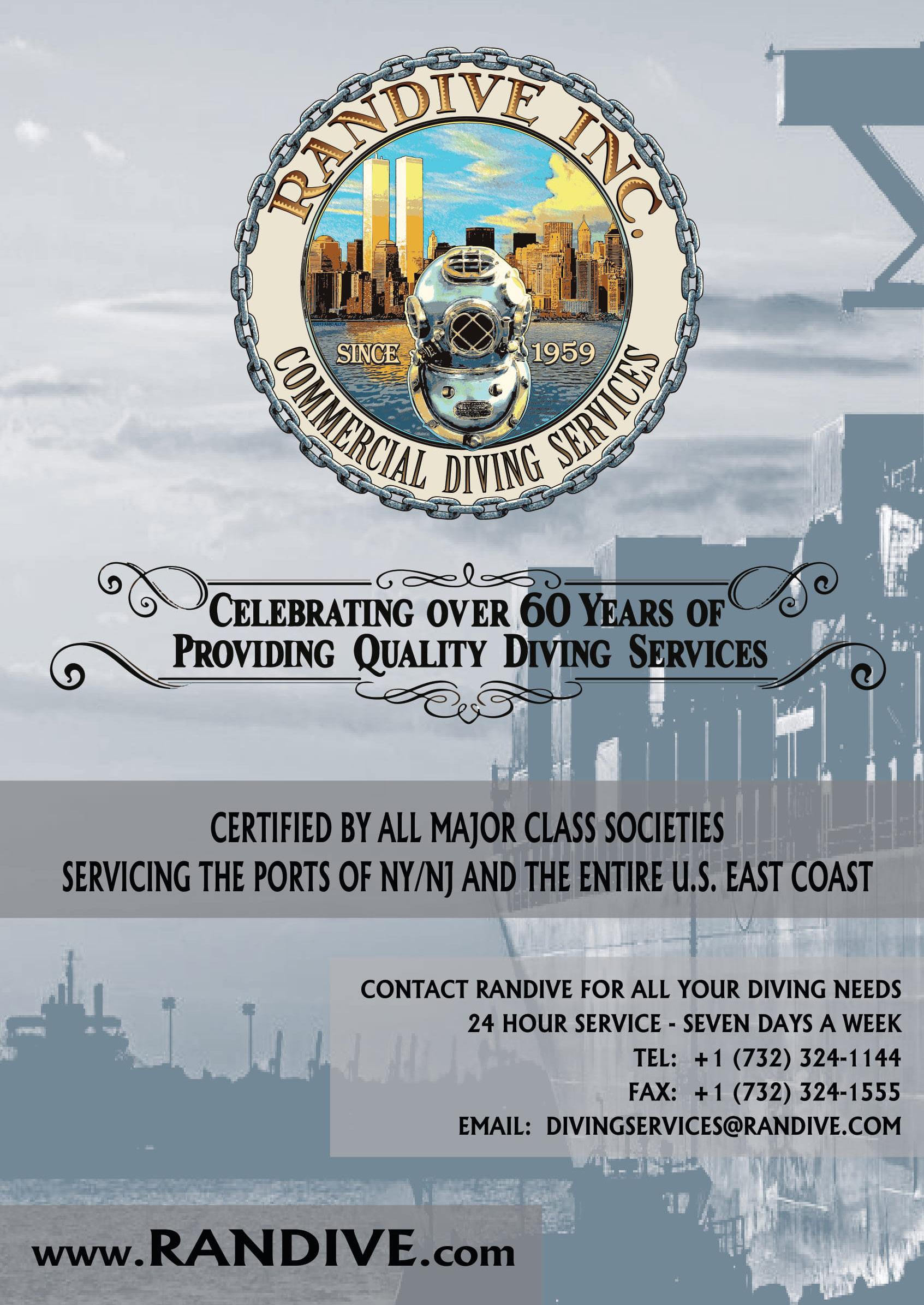
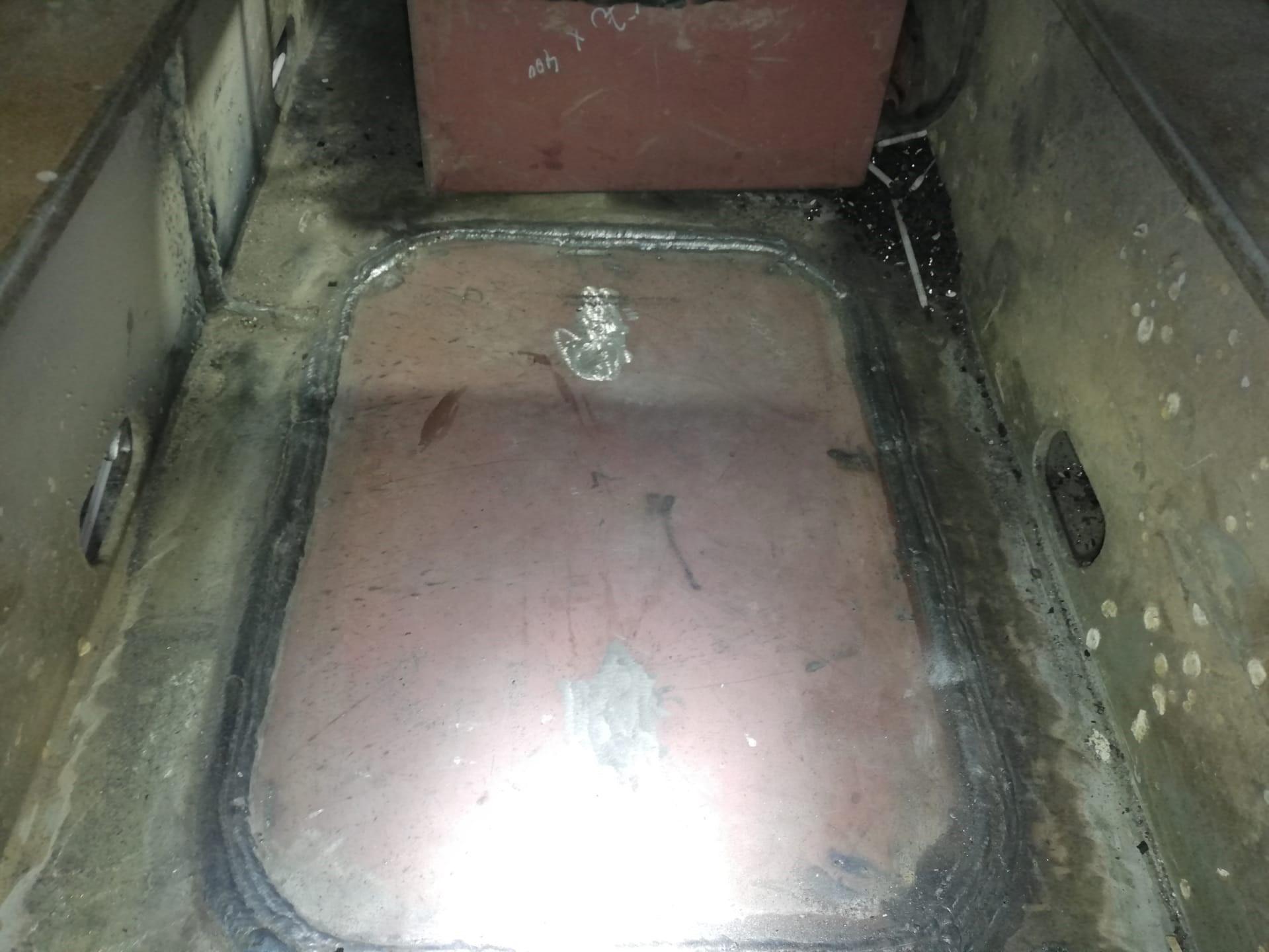
The new insert installed on the containership
in Spain.
After the team set up a monitoring station, the diver/technicians detached the blades one by one. In the meantime preparations were made in the bow thruster engine room for the underwater removal of the unit to avoid any ingress of water once it was taken out.
The next step was to secure the gearbox with hoisting equipment. The team then disconnected the unit from the bow thruster engine room and lowered it onto a cradle. This cradle was designed especially for such operations. The bow thruster was then brought to the surface. Simultaneously the team sealed off the tunnel from the bow thruster room. Once the unit was lifted onto the quay it was prepared for transport to the workshop.
The ship in Zeebrugge could be trimmed enough to raise most of the bow thruster tunnel above the water. This allowed our team to manoeuvre the thruster unit inside the tunnel with the propeller blades already installed. Next temporary metal plates were used to seal off the bottom of the tunnel. The divers could then empty the remaining water and perform the required welding work on the thruster brackets and the tunnel grids in dry conditions.
Ever since Hydrex was founded in 1974 it has strived to keep the impact of repairs for the owner as minimal as possible. By performing these thruster operations afloat, divers made it possible for the owners to keep their vessels out of drydock and avoid downtime.
Hydrex worked in shifts around the clock and finished the jobs within the available time frames. This allowed the ships to sail on schedule, which was a key benefit for the customers.
Over the last few months Hydrex has travelled across Europe to perform hull repairs on a wide range of vessels, including a cruiseship, a container vessel, a drill ship, a ro/ ro vessel and a tanker.
In Rotterdam Hydrex divers performed insert repairs on a 145 m tanker and a 300 m containership. These operations were carried out afloat with the use of an external cofferdam.
A wide range of standard cofferdams is available at the Hydrex offices, but a tailormade cofferdam can also be created to fit a specific hull shape. This was the case for the insert repair on a 228 m drill ship in Palermo, Italy.
Hydrex divers started an insert operation by installing a cofferdam on the waterside of the affected plating. Next they remove any frame, pipe or other obstacle covering the area on the inside. The damaged plating is cleaned and prepared for the operation.
A section of the damaged plating is then removed. The size of this area is decided in communication with the classification society and the owner. Next the team prepares the edges of the hole for the insert and they position the new plate. The insert is then welded following the Hydrex procedure for insert plates, using a full penetration weld.
Next an independent inspector carries out ultrasonic testing and the repair is approved by the classification surveyor who is present during the operation. Finally the diver/technicians reinstall any obstacles they removed and detach the cofferdam from the hull.
For smaller damages like crack repairs, it is not always necessary to install a new insert. This was the case for a 180 m ro/ro vessel in Zeebrugge, Belgium that had a leak in its ballast tank. Because the Hydrex fast response centres have a large stock of state-of-the-art equipment ready, mobilisation for smaller operations like this can be almost immediately.
When the work area was certified gas free, the divers started the operation with an inspection of the damaged area and this on both sides of the hull. Next the team installed a cofferdam on the outside of the hull. This allowed them to perform work on the crack inside the ballast tank without water ingress. The team then removed the frames to get access to the crack and take the exact measurements - 510 mm. The crack was ground out over its entire length and filled with our class approved full penetration welding.
The repair was inspected and approved by the attending class surveyor. It was concluded by removing the cofferdam. As a result of this temporary repair the owner of the vessel did not have to go off schedule for an emergency visit to drydock but could make arrangements for a follow up repair at a more convenient time and location.
Double Bow Thruster removal by SGS
A valued client contacted US-based Subsea Global Solutions (SGS) requiring underwater support to remove two of its existing bow thrusters during the vessel’s port call in Long Beach, California. The client indicated that they would not be replacing the thrusters at this time as no spares were available, as such SGS was asked to remove the damaged thrusters and install class approved blind covers over the hull openings. All work needed to be done during the vessel’s cargo operations and in a dry environment (underwater) to avoid potential oil spills and sea water ingress through the propeller hub. Considering SGS has had a history with this vessel and its owners, and having performed hundreds of similar thruster

The double thruster being removed
removal and installations afloat in the past, we already had the related equipment and special tooling ready to execute the work as well as the means to palletise and ship the damaged thrusters out of our work shop in Long Beach.
The SGS centralised Technical Repair Department and SGS Long Beach worked closely with the bow thruster OEM and vessel owners to outline our unique thruster removal procedure afloat and once the procedure and risk assessment were approved by the relevant parties, we planned to complete the project working around the clock in 11 x 12-hour shifts with a team for each thruster unit. Each team was composed of a topside technical team with three commercial diver technicians, two commercial diver/welder technicians, and one dive supervisor along with a floating project manager from SGS Long Beach.
The project began with the dive team installing 10-ton pad eyes in and above the thruster tunnels using underwater welding procedures in accordance with the Class A requirements of AWS D3.6M: Underwater Welding Code in the overhead (4F) and vertical (3F) positions. In conjunction with the main rigging points, 1-ton pad eyes were installed in the thruster tunnels for the thruster blade removal. All four blades needed to be removed prior to removing the thruster unit. The divers installed thruster habitat doors on both sides of the thruster tunnels and de-watered the tunnels with compressed air so the thruster blades could be removed and the blind cover plates could be installed on the blade openings.
In parallel, our internal team was disconnecting shaft couplers and rigging the thruster E-motors to pre-fabricated cradles to gain access to the top of the thruster mounting flange for each thruster. They installed an onsite SGS designed thruster dome/cofferdam that incorporates a unique centre cabling system with a pressure safe packing gland that enables a rigging cable to be shackled to the lifting eye of the thruster pinion shaft. This allows the internal team to lower the full weight of bow thruster unit safely with no water ingress in the bow thruster room. Once the bow thrusters were lowered enough to clear the pinion shafts, the loads were transferred from the centre cable to the underwater tunnel rigging, and then transferred to a 10-tonne lift bag, and finally to a pier side crane that could safety retrieve the bow thruster units.
With both thrusters safely on the pier, the commercial dive teams prepared the sealing surfaces in both tunnel thruster openings by cleaning the mounting flanges and installing new O-ring seals. They rigged each blind cover plate into position with alignment pins using the centre rigging cable through the thruster dome so the internal team could raise the blind covers into position and seal off each opening with 5-tonnes of internal pressure. The internal team could now safely remove the thruster dome and install the original thruster mounting bolts to the OEM torque specifications.
The vessel was able to sail with no restrictions after a final inspection with Class. The benefits of removing a damaged bow thruster afloat are many. The customer was able to prevent further damage to the bearings and gears caused by the presence of sea water in the gear housing and the procedures allows the units to be overhauled prior to the vessels next dry-dock— or, they can be re-installed afloat by SGS, which would help to eliminate the need for additional tug cost.
Having a centralised Technical Repair Department makes a difference when managing complex underwater repairs on a global scale, as it allows SGS to ensure both our Clients and Class receive the same familiar experience from SGS they are used to, regardless of where the project is taking place. Stay tuned for our second part of this article related to the installation of the overhauled thrusters.
SORJ
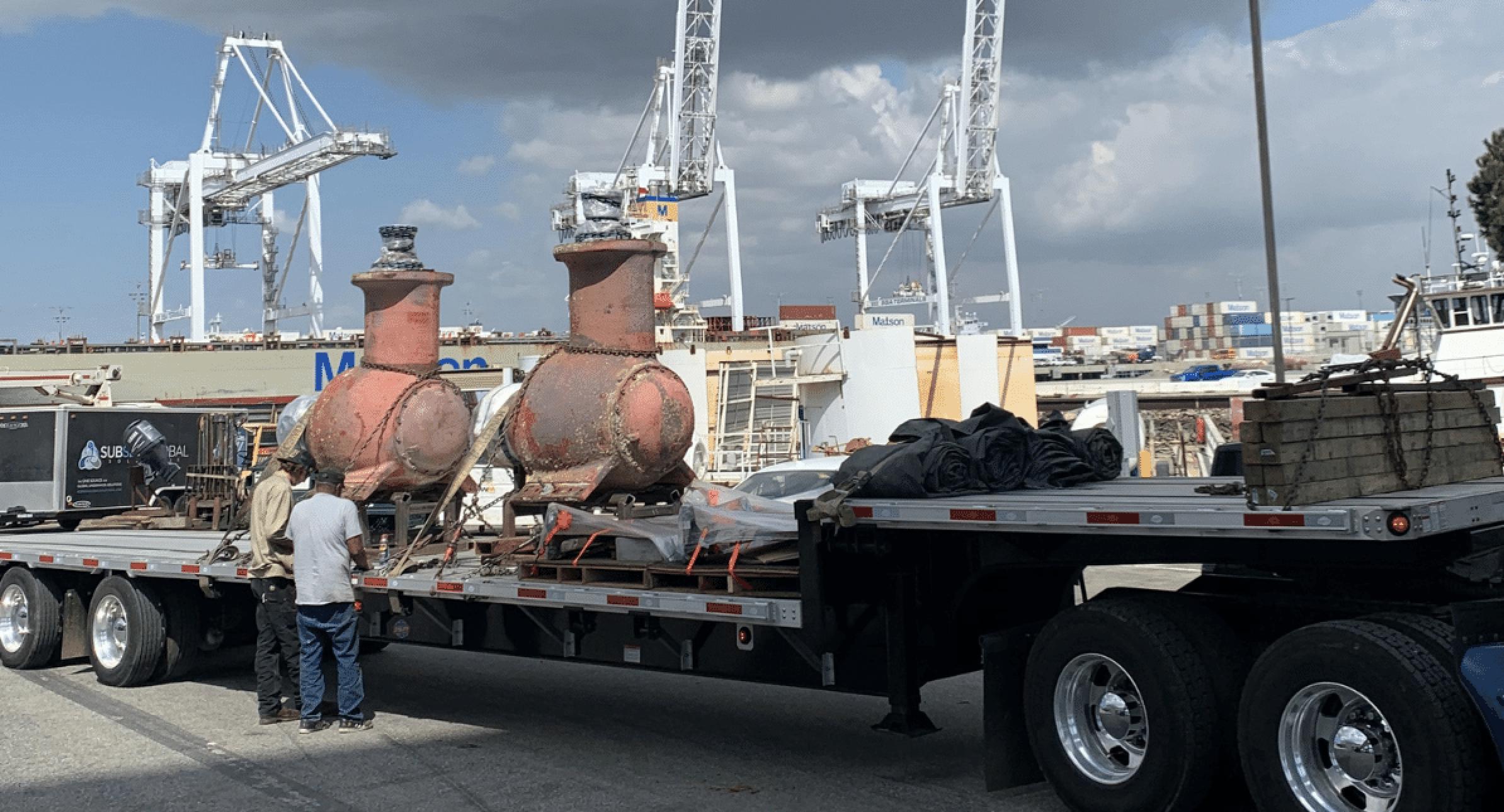
The thrusters being taken away
